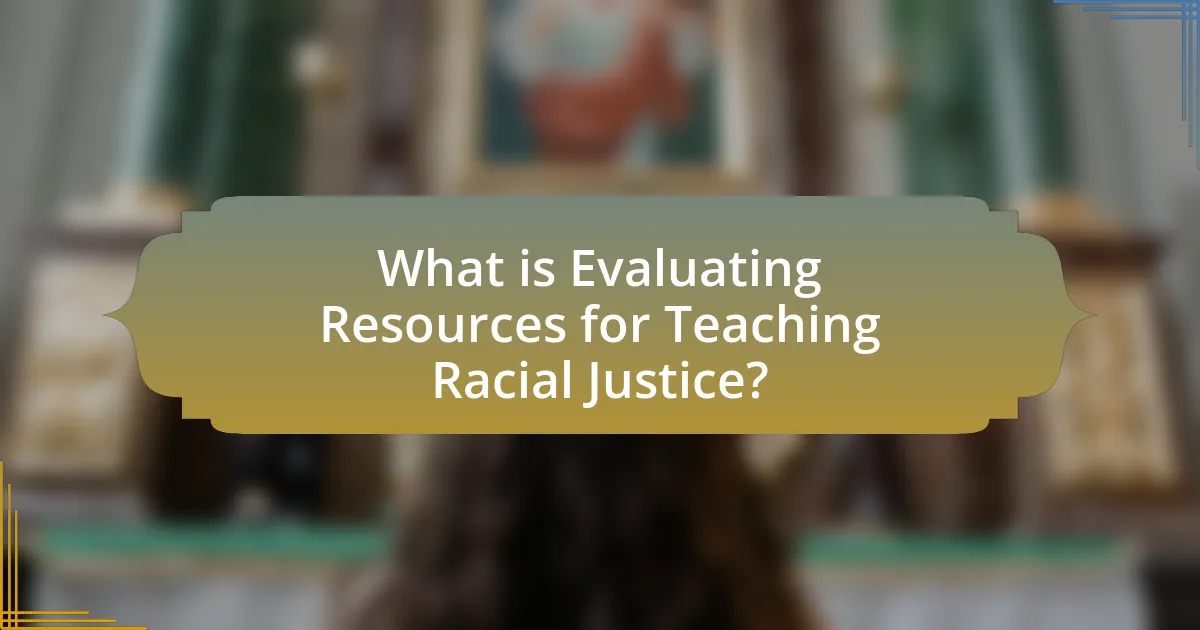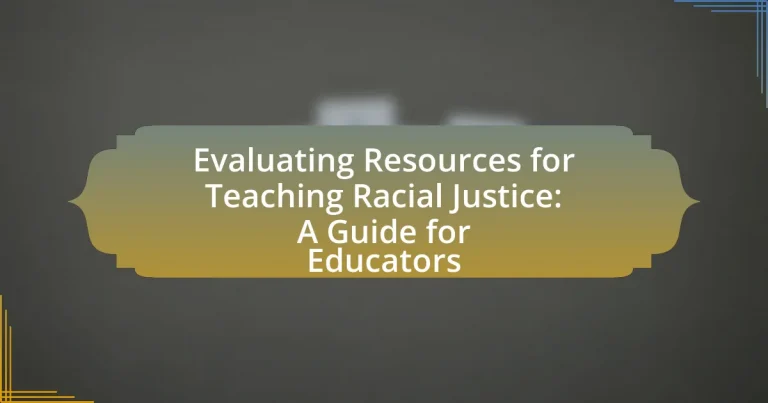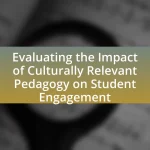Evaluating Resources for Teaching Racial Justice is a critical process that involves assessing educational materials to ensure they effectively promote understanding of racial justice issues. The article outlines the importance of evaluating resources based on criteria such as credibility, relevance, accuracy, bias, and pedagogical effectiveness. It discusses the types of resources available, including curricula, literature, and multimedia, and emphasizes the need for inclusivity and diverse representation in educational materials. Additionally, the article addresses the challenges educators face in resource evaluation and offers strategies for integrating evaluated resources into teaching practices, ultimately aiming to enhance student engagement and understanding of racial justice.

What is Evaluating Resources for Teaching Racial Justice?
Evaluating Resources for Teaching Racial Justice involves assessing educational materials and tools to ensure they effectively promote understanding and awareness of racial justice issues. This evaluation process includes examining the accuracy, relevance, and inclusivity of the content, as well as its alignment with educational goals related to equity and social justice. Research indicates that using well-evaluated resources can enhance students’ critical thinking and empathy towards diverse perspectives, which is essential in fostering a more equitable learning environment.
Why is it important to evaluate resources for teaching racial justice?
Evaluating resources for teaching racial justice is crucial to ensure that the materials are accurate, relevant, and promote an inclusive understanding of racial issues. Accurate resources help educators present factual histories and diverse perspectives, which are essential for fostering critical thinking and empathy among students. For instance, studies show that curricula incorporating diverse voices can improve student engagement and understanding of systemic racism, as highlighted in the research by the Southern Poverty Law Center, which emphasizes the importance of using vetted materials that reflect a variety of experiences and viewpoints.
What criteria should educators use when evaluating these resources?
Educators should use criteria such as credibility, relevance, accuracy, bias, and pedagogical effectiveness when evaluating resources for teaching racial justice. Credibility involves assessing the author’s qualifications and the source’s reputation, ensuring that the information is reliable. Relevance pertains to how well the resource aligns with educational goals and the specific context of racial justice. Accuracy requires verifying the factual correctness of the content, while bias involves identifying any potential partiality that may affect the presentation of information. Lastly, pedagogical effectiveness evaluates whether the resource engages students and promotes critical thinking about racial justice issues. These criteria are essential for ensuring that educators select high-quality materials that foster an informed understanding of racial justice.
How do these criteria impact the effectiveness of teaching racial justice?
The criteria for evaluating resources significantly impact the effectiveness of teaching racial justice by ensuring that materials are accurate, relevant, and culturally responsive. Accurate resources provide factual information about historical and contemporary issues related to racial justice, which is essential for fostering informed discussions. For instance, using primary sources like the Civil Rights Act of 1964 allows educators to present authentic narratives that resonate with students. Relevant resources connect racial justice topics to students’ lives, enhancing engagement and understanding. Culturally responsive materials reflect diverse perspectives, promoting inclusivity and empathy among students. Research indicates that culturally relevant pedagogy improves student outcomes by validating their experiences and identities, as shown in the work of Ladson-Billings (1994) in “The Dreamkeepers.” Thus, the criteria for evaluating resources directly influence the depth and effectiveness of racial justice education.
What types of resources are available for teaching racial justice?
Various resources are available for teaching racial justice, including educational curricula, literature, multimedia materials, and community engagement programs. Educational curricula often include lesson plans and activities designed to foster discussions about race and equity, such as those provided by organizations like Teaching Tolerance. Literature resources encompass books and articles that address racial issues, including works by authors like Ibram X. Kendi and Robin DiAngelo, which provide historical context and personal narratives. Multimedia materials, such as documentaries and podcasts, offer visual and auditory perspectives on racial justice topics, enhancing understanding through diverse formats. Community engagement programs, including workshops and local activism initiatives, allow educators to connect classroom learning with real-world applications, promoting active participation in racial justice efforts.
What are the differences between primary and secondary resources?
Primary resources are original materials created during the time under study, while secondary resources analyze, interpret, or summarize primary sources. For example, a diary from a historical figure is a primary resource, whereas a biography about that figure is a secondary resource. Primary resources provide firsthand evidence, while secondary resources offer context and analysis based on those original materials.
How can multimedia resources enhance the teaching of racial justice?
Multimedia resources enhance the teaching of racial justice by providing diverse perspectives and engaging formats that facilitate deeper understanding. These resources, such as videos, podcasts, and interactive websites, allow educators to present complex historical and social issues in a relatable manner. For instance, studies show that visual storytelling can evoke empathy and promote critical thinking, making the content more impactful. Research from the National Museum of African American History and Culture indicates that multimedia tools can effectively convey the emotional weight of racial injustices, thereby fostering a more profound connection to the subject matter among students.
How can educators ensure inclusivity in their resource selection?
Educators can ensure inclusivity in their resource selection by actively seeking materials that represent diverse perspectives and experiences. This involves evaluating resources for their cultural relevance, accuracy, and potential biases, ensuring that they reflect the voices of marginalized communities. Research indicates that inclusive educational materials can enhance student engagement and learning outcomes, as they foster a sense of belonging and validation among all students. For instance, a study by the National Education Association found that culturally relevant pedagogy improves academic performance and social-emotional development in diverse classrooms.
What role does diverse representation play in educational resources?
Diverse representation in educational resources enhances inclusivity and promotes a broader understanding of different cultures and perspectives. This representation allows students from various backgrounds to see themselves reflected in the materials they study, which can improve engagement and academic performance. Research indicates that when students encounter diverse narratives, they develop critical thinking skills and empathy, fostering a more equitable learning environment. For instance, a study by the American Educational Research Association found that diverse curricula positively impact student achievement and social-emotional development.
How can educators assess the cultural relevance of resources?
Educators can assess the cultural relevance of resources by evaluating their alignment with the diverse cultural backgrounds and experiences of their students. This involves analyzing the content for representation, accuracy, and inclusivity of various cultural perspectives. For instance, resources should reflect the histories, contributions, and narratives of marginalized communities, ensuring that students see themselves represented. Additionally, educators can utilize frameworks such as culturally responsive pedagogy, which emphasizes the importance of connecting learning materials to students’ cultural contexts. Research indicates that culturally relevant teaching improves student engagement and academic success, as highlighted in the work of Gloria Ladson-Billings, who emphasizes the need for educational practices that affirm students’ cultural identities.

What challenges do educators face when evaluating resources for teaching racial justice?
Educators face several challenges when evaluating resources for teaching racial justice, including the complexity of the subject matter, the potential for bias in materials, and the need for age-appropriate content. The complexity arises from the multifaceted nature of racial justice, which encompasses historical, social, and political dimensions that can be difficult to convey accurately. Additionally, many resources may reflect the biases of their authors or publishers, making it essential for educators to critically assess the credibility and perspective of the materials. Furthermore, ensuring that the content is suitable for the developmental levels of students adds another layer of difficulty, as educators must balance depth of information with accessibility. These challenges necessitate a careful and informed approach to resource evaluation to effectively teach racial justice.
How can biases affect the evaluation of teaching resources?
Biases can significantly distort the evaluation of teaching resources by influencing the perceptions and judgments of educators. For instance, confirmation bias may lead educators to favor resources that align with their pre-existing beliefs about racial justice, while disregarding those that challenge their views. Research indicates that biases can result in the selection of materials that perpetuate stereotypes or fail to represent diverse perspectives, ultimately impacting the quality of education provided. A study by the American Educational Research Association highlights that biased evaluations can reinforce systemic inequalities in educational settings, demonstrating the critical need for awareness and mitigation of biases in resource evaluation.
What strategies can educators use to identify and mitigate biases?
Educators can identify and mitigate biases by implementing reflective practices, utilizing diverse resources, and fostering open discussions. Reflective practices involve self-assessment and critical examination of one’s own beliefs and assumptions, which can reveal personal biases. Utilizing diverse resources, such as literature and media from various cultural perspectives, helps educators recognize and address biases in curriculum content. Fostering open discussions in the classroom encourages students to share their experiences and perspectives, promoting awareness of biases and facilitating a more inclusive environment. Research indicates that these strategies can lead to improved cultural competence among educators and students, ultimately contributing to a more equitable educational experience.
How can peer reviews assist in overcoming these challenges?
Peer reviews can assist in overcoming challenges in evaluating resources for teaching racial justice by providing critical feedback and diverse perspectives. This collaborative process allows educators to identify biases, inaccuracies, and gaps in the materials being assessed. Research indicates that peer-reviewed resources are more likely to meet academic standards and reflect a balanced viewpoint, which is essential in sensitive topics like racial justice. For instance, studies show that peer-reviewed articles in education often undergo rigorous scrutiny, enhancing their credibility and effectiveness in teaching.
What are common pitfalls in resource evaluation?
Common pitfalls in resource evaluation include a lack of critical analysis, reliance on outdated materials, and failure to consider diverse perspectives. Educators often overlook the importance of assessing the credibility and relevance of sources, which can lead to the inclusion of biased or inaccurate information. Additionally, many evaluations do not account for the cultural context of the materials, resulting in resources that may not effectively address the complexities of racial justice. Research indicates that resources lacking in diversity can perpetuate stereotypes and fail to engage students meaningfully, highlighting the necessity for thorough evaluation processes that prioritize inclusivity and accuracy.
How can reliance on outdated materials hinder effective teaching?
Reliance on outdated materials can significantly hinder effective teaching by limiting educators’ ability to provide relevant and accurate information. Outdated resources may contain obsolete facts, perspectives, or methodologies that do not reflect current understanding or societal changes, particularly in the context of teaching racial justice. For instance, educational materials that fail to incorporate recent research on systemic racism or contemporary social movements can misinform students and perpetuate stereotypes. Studies have shown that using current, diverse, and inclusive resources enhances student engagement and understanding, thereby improving educational outcomes. Therefore, outdated materials can obstruct the teaching process by failing to equip students with the knowledge necessary to navigate and understand today’s complex social landscape.
What are the risks of using resources that lack scholarly backing?
Using resources that lack scholarly backing poses significant risks, including the dissemination of misinformation, the promotion of biased perspectives, and the undermining of educational integrity. Misinformation can lead to the spread of false narratives, which can distort understanding of racial justice issues. Biased perspectives may reinforce stereotypes or perpetuate systemic inequalities, ultimately hindering effective teaching and learning. Furthermore, reliance on unverified sources can compromise the credibility of educators and their institutions, as scholarly backing is essential for establishing trust and authority in educational contexts.

How can educators effectively implement evaluated resources in their teaching?
Educators can effectively implement evaluated resources in their teaching by integrating them into lesson plans that align with curriculum objectives. This involves selecting resources that have been vetted for accuracy, relevance, and cultural sensitivity, particularly in the context of teaching racial justice. For instance, using resources from organizations like Teaching Tolerance, which provides materials that promote equity and inclusivity, can enhance classroom discussions and foster critical thinking. Research indicates that when educators utilize high-quality, evaluated resources, student engagement and understanding of complex social issues improve, as evidenced by studies showing increased empathy and awareness among students exposed to diverse perspectives.
What strategies can educators use to integrate these resources into their curriculum?
Educators can integrate resources for teaching racial justice into their curriculum by employing strategies such as thematic units, project-based learning, and collaborative discussions. Thematic units allow educators to connect various subjects around the central theme of racial justice, facilitating a comprehensive understanding. Project-based learning encourages students to engage with real-world issues related to racial justice, fostering critical thinking and problem-solving skills. Collaborative discussions create a safe space for students to express their thoughts and experiences, promoting empathy and understanding. Research indicates that these strategies enhance student engagement and comprehension of complex social issues, making them effective for integrating racial justice resources into educational settings.
How can lesson plans be adapted to include evaluated resources?
Lesson plans can be adapted to include evaluated resources by integrating materials that have undergone a rigorous assessment process for their relevance, accuracy, and effectiveness in teaching racial justice. Educators should select resources that have been vetted by experts in the field, such as peer-reviewed articles, educational frameworks, or guidelines from reputable organizations focused on racial equity. For instance, the Teaching Tolerance project provides a wealth of evaluated resources that align with best practices in teaching about race and social justice. By incorporating these vetted materials, educators ensure that their lesson plans are not only informative but also promote critical thinking and awareness among students regarding racial issues.
What role does student feedback play in refining resource use?
Student feedback plays a crucial role in refining resource use by providing educators with insights into the effectiveness and relevance of teaching materials. This feedback allows educators to identify which resources resonate with students and which do not, enabling them to make informed adjustments. For instance, studies have shown that incorporating student evaluations can lead to improved engagement and understanding of complex topics, such as racial justice, by aligning resources with student needs and perspectives. By actively seeking and analyzing student feedback, educators can enhance the educational experience and ensure that resources are utilized effectively to promote learning outcomes.
What best practices should educators follow when teaching racial justice?
Educators should prioritize creating an inclusive curriculum that reflects diverse perspectives and histories related to racial justice. This involves integrating materials that highlight the contributions and experiences of marginalized communities, ensuring that students understand systemic racism and its impact. Research indicates that inclusive education fosters empathy and critical thinking, which are essential for addressing social injustices. For example, a study by the American Educational Research Association found that students exposed to diverse narratives demonstrate greater awareness of social issues and are more likely to engage in civic activities. Additionally, educators should facilitate open discussions that encourage students to express their thoughts and feelings about race, promoting a safe environment for dialogue. This approach not only enhances understanding but also empowers students to become advocates for change.
How can ongoing professional development support effective resource evaluation?
Ongoing professional development enhances effective resource evaluation by equipping educators with updated knowledge and skills necessary for critically assessing teaching materials. This continuous learning process fosters a deeper understanding of racial justice issues, enabling educators to identify biases and gaps in resources. Research indicates that educators who engage in regular training are more adept at evaluating the relevance and appropriateness of resources, as they are exposed to diverse perspectives and methodologies. For instance, a study by the National Education Association highlights that professional development focused on equity and inclusion significantly improves educators’ ability to select and utilize resources that promote social justice in the classroom.
What collaborative approaches can enhance resource evaluation among educators?
Collaborative approaches that can enhance resource evaluation among educators include peer review, co-creation of evaluation criteria, and professional learning communities. Peer review allows educators to assess resources collectively, ensuring diverse perspectives and expertise are considered, which can lead to more comprehensive evaluations. Co-creating evaluation criteria fosters a shared understanding of what constitutes quality resources, aligning educators’ goals and expectations. Professional learning communities provide a structured environment for ongoing dialogue and feedback, enabling educators to share insights and best practices related to resource evaluation. These methods have been shown to improve the quality of resource selection and implementation in educational settings, particularly in the context of teaching racial justice.
What practical tips can educators use for evaluating resources for teaching racial justice?
Educators can evaluate resources for teaching racial justice by applying a critical lens to the content, ensuring it is accurate, inclusive, and relevant. First, they should assess the credibility of the authors and organizations behind the resources, looking for qualifications and expertise in racial justice issues. Additionally, educators should examine the perspectives represented in the materials, ensuring diverse voices and experiences are included, particularly those of marginalized communities.
Furthermore, educators can analyze the context in which the resource was created, considering historical and social factors that may influence its perspective. They should also verify the factual accuracy of the information presented, cross-referencing with reputable sources and research studies on racial justice. Lastly, educators can seek feedback from peers or community members to gauge the resource’s effectiveness and appropriateness for their specific educational setting.


